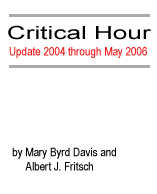Critical Hour: Update 2004-May 2006
Synopsis
[Note: This update corresponds to Critical Hour: Three Mile Island, The Nuclear Legacy, And National Security by Albert J. Fritsch, Arthur H. Purcell, and Mary Byrd Davis. Free download.]
Given the Bush administration’s intensifying attempts to revise the commercial nuclear industry and given the general lack of commitment on the part of the administration and of the American public to energy efficiency and mature renewable energy technologies, we felt it incumbent on us to update Critical Hour. The nuclear industry poses even more of a threat to the welfare of the United States and other nations than it did in 2003 when we completed our research for Critical Hour. Furthermore, the now-overwhelming evidence of climate change demands that we adopt currently available means of reducing fossil fuel consumption.
Commercial nuclear reactors are even more dangerous than they were in late 2003, because aging makes reactor components increasingly fragile and susceptible to breakdowns and because all US reactors are now older and many are being authorized to operate for sixty years. The impact of normally operating reactors on human health and the environment has not changed, but is now more obvious, as a committee of the National Research Council has confirmed that even low doses of ionizing radiation can cause cancer. The radioactive waste problem has become more acute as reactor waste continues to pile up: after mid-2008 there may be no place to put newly created low-level waste, and the US Department of Energy is years behind in filing a license request for the Yucca Mountain repository for high-level waste. The US Nuclear Regulatory Commission has still not done all it could to protect civilian reactors and their irradiated fuel storage pools from terrorists, although they remain tempting targets. Nevertheless, the Bush administration is using tax payers’ money to push the construction of new commercial reactors and to develop a dangerous, expensive, and unworkable program, the Global Nuclear Energy Partnership, which would include the development within the United States of the reprocessing of irradiated fuel and the construction of fast neutron reactors. Nuclear power is not the answer to global warming, and development and large-scale implementation of new technologies for using fossil fuels, even if feasible, would demand time that is not available. Energy efficiency and use of mature renewable resources can turn the tide, but voluntary lifestyle changes are proving to be insufficient. We are therefore forced to modify our original proposal to include more governmental regulation and incentives.
In this update we do not cover the internationalization of the commercial nuclear industry, even though we touched on it in the original Critical Hour. The subject has become so complex that we could not treat it adequately within the context of this update. As in the original Critical Hour, we also do not go into the relationship between nuclear power and nuclear weapons. The authors hope to take up both these subjects in separate publications in the coming months.
Keywords addressed in this update include: nuclear safety, Global Nuclear Energy Partnership, Nuclear Power 2010, GNEP, Chernobyl, Yucca Mountain, low-level radioactive waste, high-level radioactive waste, anti-nuclear movement, renewable energy, solar, wind, geothermal, biodiesel, ethanol, hydroelectric, CFLs, aging, breeder reactors, Catawba, Chernobyl, combined construction and operating license (COL), Davis Besse, design basis threat (DBT), early site permit, Energy Policy Act of 2005, fuel pools, Generation III reactors, Generation IV reactors, Greenspirit, low-level radiation, North Anna, nuclear subsidies, nuclear terrorism, US Department of Energy, US Nuclear Regulatory Commission, precursor events, Private Fuel Storage, reprocessing, tritium leaks

